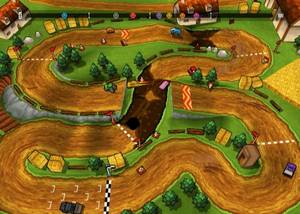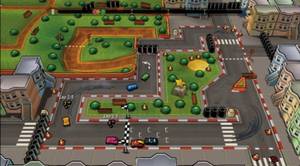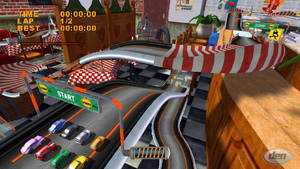Developing a Mini Racing Game
Semester: |
WS 2012 |
Type: |
Pro-Practical |
Lecturer: |
|
Credits: |
|
Links: |
Campus, Results |
Find a list of current courses on the Teaching page.
Type |
Date |
Room |
|---|---|---|
| PreMeeting | 2nd Aug 2012, 14:00 - 16:00 | 6317 |
| Kick-Off Meeting | 21st Aug 2012, 14:00 - 18:00 | 6317 |
| Semester-Start Meeting | 18th Sep 2012, 14:00 - 16:00 | 6317 |
| Milestone1 | 13rd Nov 2012 | |
| Milestone2 | 18th Dec 2012 | |
| Milestone3 | 22nd Jan 2013 | |
| Final Release | 29th Jan 2013 |
In this practical course, the students will implement a Mini Racing game, which combines the toy car racing with eye catching 3D visual effects (cf. Driift Mania, Micro Machines).


The game will be a single-player game for PC platform. Participants will work in small teams. Within each team, there will be subteams concentrating on the game engine (graphics and physics) or the content creation. Although the students can focus on a smaller problem, they have to ensure that their parts fit into the whole framework of the game. Therefore, the intercommunication between the groups is of a very high priority in order to define precise interfaces and common data structures.
Basically, students will learn to organize themselves as part of a bigger project. Depending on the topic of the group, students will learn to implement a specific part of a game.
-
Graphics:
For a high visual quality of the game, students will have to implement several shaders in the rendering pipeline that is based on OpenGL. This includes effects like complex materials (e.g. relief mapping) and post processing effects (e.g. glow, deferred lighting, motion blur, reflection). A template based on ACGL (Aachen Computer Graphics Library, a high level abstraction of OpenGL) will be provided for a quick start.
-
Physics:
Since it is a racing game, students will use Bullet physics library to do the physics simulation, like collision, drift and gravity. The movement of the toy cars will be restricted by the static world geometries, e.g. knocked back by the border or hit road blockers, and affected by dynamic objects, e.g. other toy cars. Students should also handle the event trigger, e.g. earn speed boost when hit bonus box.
-
Content Creation:
Students will have to create the game world, i.e. racing scene. Since this kind of modeling should be done on a very high abstraction level, single instances of geometry will have to be created with common tools like blender or 3dsmax. Furthermore, the group has to create the textures for the geometry, which can be done with tools like gimp or photoshop.
Every group can propose its favourite theme of the racing track, e.g. desert rally, sci-fi space.
Software Engineering
The course will teach the participants how to develop a complex project using software engineering techniques.


-
Application Specification:
In our scenario, the supervisors will provide a description for each part of the project. The students have to understand it and clarify any questions in the first stage of the project.
-
Software Design:
The students have to create rough class diagrams that describe the data structures and the internal relationships of their application. The team has to organize itself and it has to set the responsibilities for the different components of the software. In this stage, any common interfaces and data structures with other groups have to be defined.
-
Coding:
Each group has to implement their specific topic. Most of the work can be done independently of other groups as long as the interfaces and data structures do not change. If any changes are necessary for a single group, it has to make an appointment with the other groups to clarify the changes as fast as possible.
-
Testing:
The students will have to test their application with artificial data as long as it is not integrated into the full framework. However, in order to ensure the quality of the product, the supervisors will also test the application from time to time and therefore the program has to run on a specific target computer that is provided by our chair.
-
Integration:
After each milestone, the groups will have to integrate the single parts in order to present the full game in regular time intervals.
-
Report:
During the course, the students should make some notes on problems, difficulties and solutions which they have chosen. At the end of the course, they have to hand in a very small report including the mentioned aspects.
Requirements
- Students have to know C/C++ programming.
- OpenGL: It would be better to know OpenGL.
- Qt Framework: It would be better to know the Qt framework.

